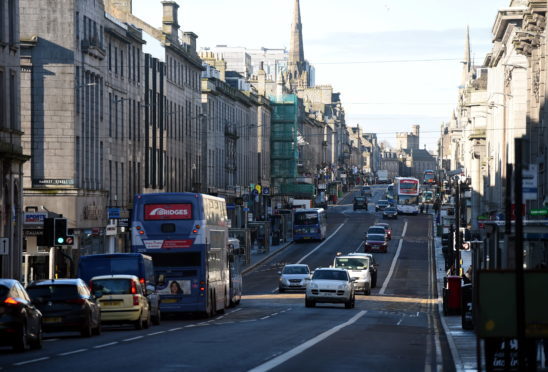Levels of air pollution on several Aberdeen streets are still “dangerously” high despite the opening of the AWPR reducing traffic in the city.
Research carried out by Friends of the Earth Scotland has revealed that Union Street, Wellington Road and Market Street are the worst areas for nitrogen dioxide in the city.
Although the opening of the city bypass reduced traffic levels on central roads which were previously clogged with traffic, the pollution recorded there is still said to be at harmful levels.
Aberdeen City Council is already investigating the possibility of creating “low emission zones”, which can either ban certain vehicles or charge them for entry into designated areas.
But yesterday, environmental activists said the latest findings showed there was an urgent need for the system to be put in place.
Friends of the Earth Scotland’s air pollution campaigner, Gavin Thomson, said: “What these figures show is the risk that people in Aberdeen city centre face from traffic fumes.
“Air pollution, particularly from older vehicles, is dangerous for our health.
“This shows why an ambitious low emission zone is essential for Aberdeen, alongside provisions to improve walking and cycling in the city centre.”
One volunteer with Aberdeen Climate Action, who asked to remain anonymous, said the pollution was so bad she could “taste and smell it”.
She said: “I’m really concerned about air pollution, especially around my kids’ school at drop off and pick up. You can really taste and smell it.
“I set up a walking bus to try and reduce traffic around the school, because I don’t want them exposed to pollution that could have long-lasting damage to their health.”
Campaigners analysed official air pollution data for 2019 said the pollution is closely tied to car traffic.
The European Ambient Air Quality Directive set a limit for NO2 annual average of 40 microgrammes per cubic metre and the deadline for compliance was supposed to be January 1, 2010.
In 2018, it emerged that the gas was as high as 48 microgrammes on some parts of Union Street.
Although this has reduced to 35 microgrammes per cubic metre, the levels still pose a threat.
The latest study also showed 34mcg on Wellington Road and 32mcg on Market Street.
Shocking new data reveals there are 13 areas with illegal levels of pollution in Aberdeen
Reader in environment science at Aberdeen University, Astley Hastings added: “The huge spending on new roads should be stopped, as that will only worsen air pollution, even with the partial electrification of cars.
“If we care about our health, and about the planet, it should be stopped and the money used to improve rail and hydrogen bus infrastructure.”
The council hopes to have the low emission zones in place by the end of the year, as part of a Scottish government commitment to drastically reduce pollution in city centres by 2030.
Last November, the authority began talks with businesses most likely to be affected by the move.
A report presented to councillors said: “Further and more detailed engagement is envisaged to take place in early 2020 as options become more defined and ready for discussion.”










